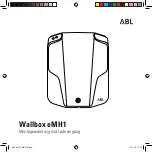
All vehicles
!
You may only secure the vehicle by the
wheels, not by parts of the vehicle such as
axle or steering components. Otherwise, the
vehicle could be damaged.
The towing eyes or trailer tow hitch can be used
to pull the vehicle onto a trailer or transporter if
you wish to transport it.
X
Vehicles with manual transmission:
depress the clutch pedal fully and engage
neutral.
X
Vehicles with automatic transmission:
turn the key to position 2 in the ignition lock.
X
Shift the automatic transmission to position
N.
As soon as the vehicle is loaded:
X
Prevent the vehicle from rolling away by
applying the electric parking brake.
X
Vehicles with manual transmission:
depress the clutch pedal fully and engage first
or reverse gear.
X
Vehicles with automatic transmission:
shift the automatic transmission to position
P.
X
Turn the key to position 0 in the ignition lock
and remove it.
X
Secure the vehicle.
Tow-starting (emergency engine
starting)
!
Do not tow-start vehicles with automatic
transmission. You could otherwise damage
the automatic transmission.
i
You can find information on "Jump-starting"
under (
Y
page 345).
Before tow-starting, the following conditions
must be fulfilled:
R
the battery is connected
R
the engine has cooled down
R
the exhaust system has cooled down
When tow-starting, it is important that you
observe the safety notes (
Y
page 347) and the
legal requirements in each respective country.
X
Switch on the hazard warning lamps
(
Y
page 120).
X
Fit the towing eye (
Y
page 348).
X
Secure the rigid towing bar or the towing
rope.
X
Depress the brake pedal and keep it
depressed.
X
Turn the key to position 2 in the ignition lock.
X
Depress the clutch pedal fully, engage 2nd
gear and continue to keep the clutch pedal
fully depressed.
X
Release the brake pedal.
X
Tow-start the vehicle.
X
Release the clutch pedal slowly; do not
depress the accelerator pedal while doing so.
X
When the engine has been started, immedi-
ately depress the clutch pedal fully and shift
to neutral.
X
Pull over at a suitable place and stop the vehi-
cle safely, paying attention to road and traffic
conditions.
X
Use the electric parking brake to secure the
vehicle and prevent it from rolling away.
X
Remove the rigid towing bar or towing rope.
X
Remove the towing eye (
Y
page 349).
X
Switch off the hazard warning lamps.
Electrical fuses
Important safety notes
G
WARNING
If you manipulate, bridge or replace a faulty
fuse with a fuse of a higher amperage, the
electric cables could be overloaded. This may
result in a fire. There is a risk of an accident
and injury.
Always replace faulty fuses with specified new
fuses of the correct amperage.
Blown fuses must be replaced with fuses of the
same rating, which you can recognise by the
colour and fuse rating. The fuse ratings are listed
in the fuse allocation chart.
The fuse allocation chart is on the fuse box in the
boot (
Y
page 352).
If the newly inserted fuse also blows, have the
cause traced and rectified at a qualified special-
ist workshop, e.g. a Mercedes-Benz Service
Centre.
!
Only use fuses that have been approved for
Mercedes-Benz vehicles and which have the
350
Electrical fuses
Br
eak
down
ass
ist
ance
















































